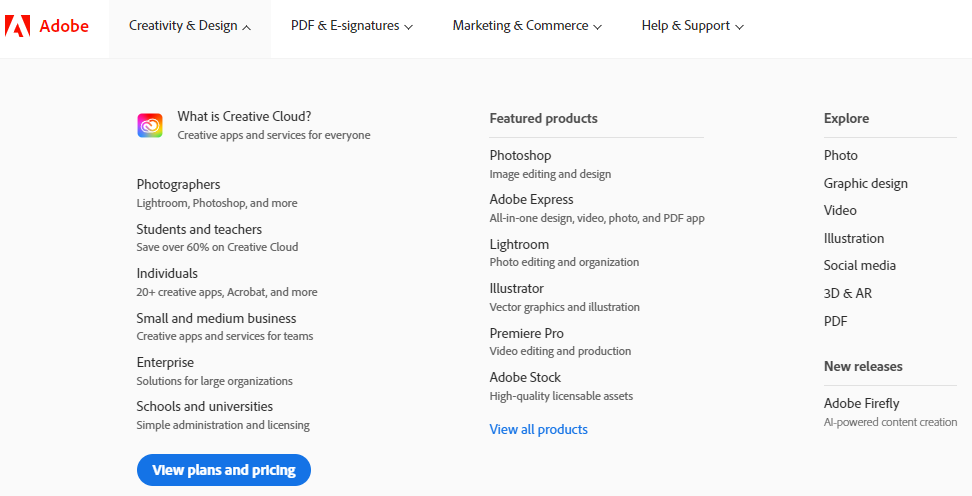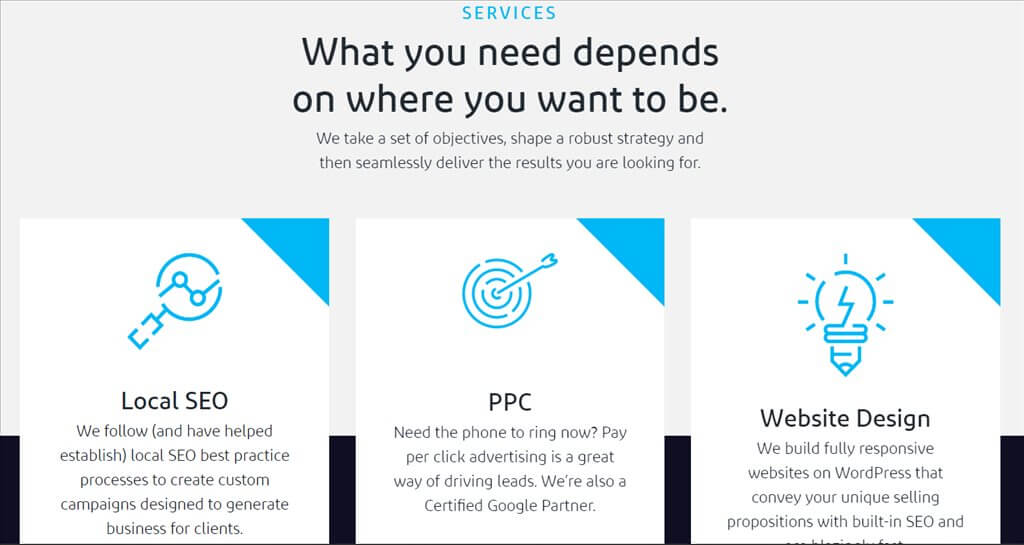Service pages are the silent workhorses, often overshadowed by flashier website elements, yet they hold incredible power to attract potential customers and drive conversions. Today, we’re turning the spotlight on these unsung heroes. We’re not just talking about their importance; we’re diving deep into how to supercharge them to fulfill user intent, a critical factor that can make or break their effectiveness.
Buckle up as we dive into RicketyRoo’s take on service pages, their intent, and how you can make them work even better for your clients.
Understanding Service Pages
Imagine a website as a bustling city. Each page is a unique shop. Service pages are the stores with lines down the block. The display windows showcase a client’s services to the world. These pages are more than just information hubs; they’re powerful marketing tools that detail your services, attract potential customers, and drive conversions.
Service pages become local guides, helping potential customers in an area find your client. You can boost your client’s online presence and business growth by providing detailed, localized information. Service pages bridge a business and its potential customers, an opportunity to showcase services and connect with its target audience. Whether you’re creating a new service page or updating an existing one, fulfilling user intent is vital.
The Importance of Fulfilling User Intent
User intent, in simple terms, is the “why” behind a user’s search. It’s the goal they have in mind when they type a query into a search engine. In the context of service pages, it’s about understanding what potential customers look for when they land on a page.
But why is fulfilling user intent so crucial for service pages? The answer lies in the direct impact it has on user experience and, consequently, conversion rates. When a service page aligns with user intent, you meet these expectations, create a positive user experience, and drive more conversions.
Search engines are becoming more adept at grasping what users are really looking for. They provide users with the most relevant results for their queries. By aligning service pages with user intent, you can increase visiblity and improve search engine rankings.
Fulfilling user intent is like speaking a customer’s language. It’s about showing them that you understand their needs, have what they’re looking for, and are the right choice for them. It’s a powerful way to connect with a target audience often overlooked when creating content on the web.
How to Identify User Intent for Service Pages
Understanding user intent is like reading the minds of your audience. It’s about knowing what they want or need even before they do.
Here are some of RicketyRoo’s strategies to help you identify user intent for new or existing service pages:
Consider the User Journey
User intent can change depending on where the user is in the buying journey. A user at the awareness stage might be looking for different information than a user at the decision stage. Tailor your content to meet users’ needs at different journey stages.
Study Search Patterns
Understanding the search patterns of your users can provide valuable insights into their intent. Look at the words and phrases people use when searching for your services. Are they using specific product names or are they using more generic terms? Are they asking questions or looking for solutions to a problem? This can give you a clue about their intent.
Use SEO Tools
SEO tools like Semrush or Ahrefs provide insights into the keywords an audience is using, which can give you clues about their intent. Google Search Console can show you what search queries are leading users to your page. If a page is ranking for irrelevant queries, its content may need to be adjusted to better match user intent.
Analyze Pain Points
Gaining insights into your users’ pain points can help you understand their intent. If you know what problems your users are trying to solve, you can tailor your service pages to provide the solutions they’re looking for. If users are frequently contacting customer support about a specific issue, consider creating content that addresses this problem. Not only will this improve the user experience, but it also helps reduce the load on your customer support team.
Customer Surveys and Feedback
Direct communication with customers provides valuable insights. Surveys, feedback forms, or interviews help you understand customers’ needs. Ask users directly about their intent, whether they found what they were looking for, and what improvements they’d suggest.
Look at the Competition
Analyzing the service pages of your competitors can provide a wealth of information. What are they doing well? Where are they falling short? This can give you insights into what potential customers might be looking for. For instance, if a competitor’s service page is ranking highly for a specific keyword, analyze their content to understand why.
Analyze User Behavior
Use analytics tools to understand how potential customers interact with your website. High bounce rates on a service page might indicate that the content isn’t aligning with user intent. If users spend a significant amount of time on a page or visit it frequently, it’s likely that the page’s content aligns with their intent. The sequence of pages a user visits can also reveal their intent.
Creating or updating existing service pages that effectively fulfill user intent is not a one-off task — especially not for RicketyRoo. It’s an ongoing process requiring consistent testing, monitoring, and optimization.
5 Tips for Creating or Updating Service Pages That Fulfill User Intent
Crafting service pages that effectively fulfill user intent is an art and a science. It’s about understanding an audience, their needs, and how they interact with a website. Let’s explore practical tips to help you create or update service pages that meet and exceed user expectations.
Craft Clear and Concise Service Descriptions
The first step in creating a service page that fulfills user intent is to provide a clear and concise description of the service. This should include what the service is, what it entails, and how it can benefit a potential customer. Avoid jargon. Keep the language straightforward. Your audience may not be familiar with industry-specific terms — don’t speak to them like they are.
Use Relevant Keywords and Phrases
We all know keywords play a crucial role in SEO. They help search engines understand the text on a page and match it with user queries. Conduct keyword research to identify phrases that potential customers use when looking for your services. Incorporate these keywords naturally into the service page.
Leverage User-Friendly Navigation

A well-structured, easy-to-navigate website significantly enhances user experience and engagement. Ensure your service pages are easily accessible from your homepage and other important pages. Use clear, descriptive navigation labels to help users find what they want. Lead potential clients through each phase of the sales funnel to the next with internal linking, clear calls to action, and visuals throughout the service page.
Incorporate User Reviews and Testimonials

User reviews and testimonials significantly boost your credibility and convince potential customers of the value of a client’s services. Encourage customers to leave reviews and feature these prominently on service pages.
Create Compelling Calls to Action

A well-designed call to action (CTA) guides users toward taking the desired action, whether filling out a contact form, scheduling a service, or purchasing. Make CTAs clear, concise, and action-oriented. Use analytics tools to understand how potential customers interact with a client’s pages. Adjust and improve your calls to action to see what works and what doesn’t.
Learn how we use Looker Studio (formerly Google Data Studio) here!
Measuring the Success of Your Service Pages
Understanding the performance of service pages is crucial. It’s not just about creating them. It’s about measuring their success and making continuous improvements. Let’s investigate how to effectively measure the success of service pages and use these insights to rank them even higher.
Set Goals for Your Service Pages
Goals should represent the overarching value a client wants out of their service pages. These could be improving user experience, promoting better performance, or reducing operational costs. Align these goals with your client’s measure of success.
Identify Relevant Metrics
Choose success metrics that align with a client’s goals and work with them to identify what they should be. These could be as simple as filling out contact forms, a potential customer picking up the phone, or something more nuanced, like new visitors to a service page vs. returning. Metrics will depend on the client and what’s essential for them to understand the success of the work you’re doing for them.
Gather and Analyze Data
Data-driven decisions are crucial for improving conversion, rankings, and more. Collect data from GA4, Google Search Console, and other tools from the moment you start working with a client to improve service page intent if you aren’t already. Use this data to make informed decisions about improving your service pages now and in the future.
Use Reporting Tools
Reporting tools help you process and understand your data. They provide actionable insights that can guide your decision-making process. They allow you not only to report on your successful service pages but help improve them, too. Ensure you’re setting up regular intervals after you’ve improved search intent on a service page to report on its success and adjust your strategy if the results aren’t what you were hoping for.
Make Continuous Improvements
Based on your ongoing analysis, continue to make necessary improvements to a client’s service pages. This involves everything from updating content, building new service pages, and continuing to improve user experience. Measuring success is a continuous process that requires regular monitoring and adjustments.
Measuring the success of your service pages involves the following:
- Setting clear goals
- Identifying relevant metrics
- Gathering and analyzing data
- Making continuous improvements based on your findings
It’s a process that requires a commitment to continuous learning and adaptation. With the right approach, you will create service pages that fulfill user intent and drive business growth for your clients now and well into the future.
The Journey to Service Page Excellence
Service pages are crucial to a client’s online presence, especially in local SEO. By understanding and fulfilling user intent at the local level, you can create service pages that rank higher in search results.
Creating effective service pages involves:
- Understanding an audience
- Writing clear and concise service descriptions
- Using relevant keywords
- Ensuring a user-friendly design
- Continuously measuring and improving performance
Local SEO and content marketing is a constantly changing playground. What works today might not work tomorrow. Like us at RicketyRoo, keep learning, testing, and adapting. Your efforts will pay off in the form of increased visibility, more customers, and higher revenue when you narrow in on the focus of your client’s service pages.
Need help with local SEO?
Schedule a discovery call with RicketyRoo
and make your mark on the map.



